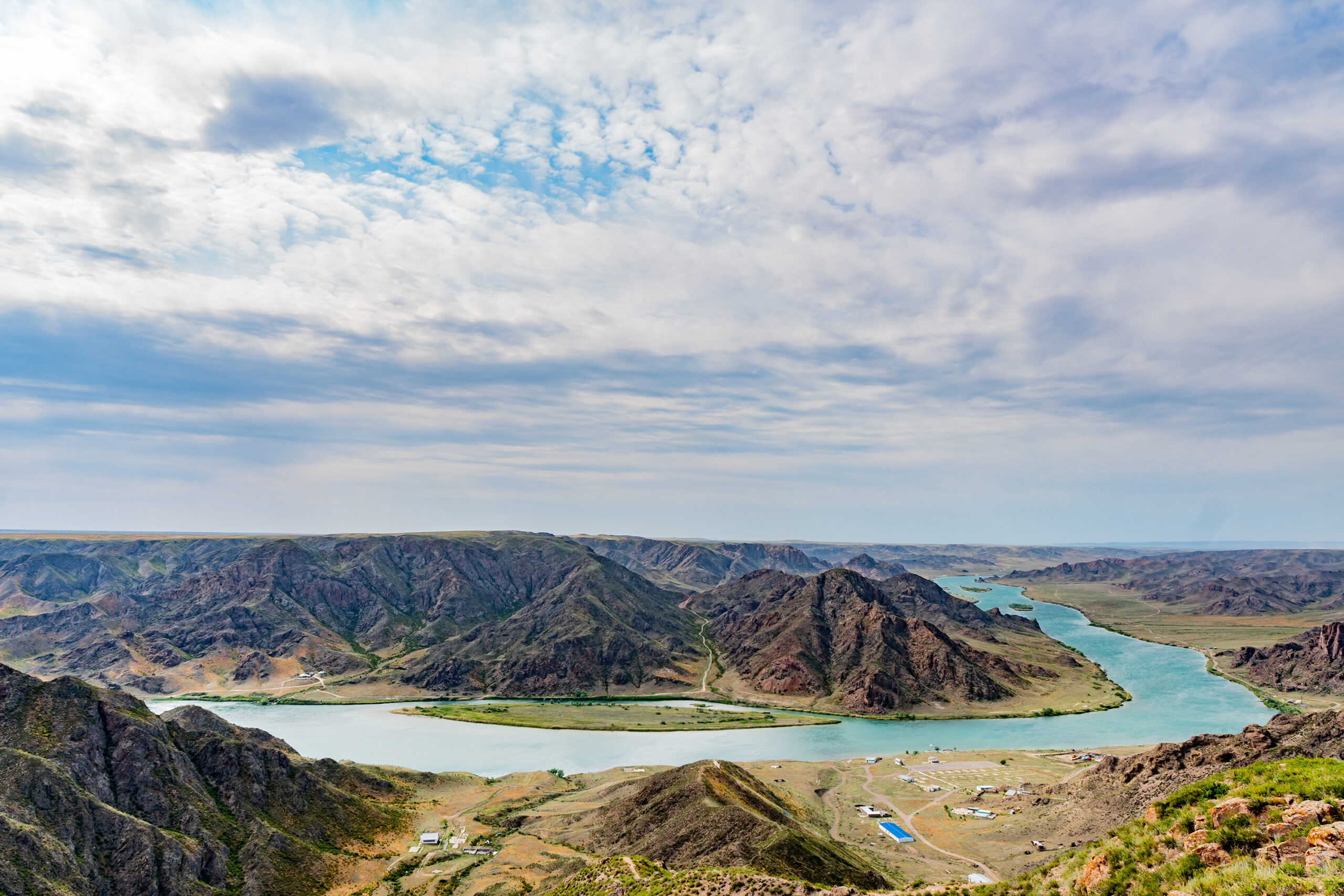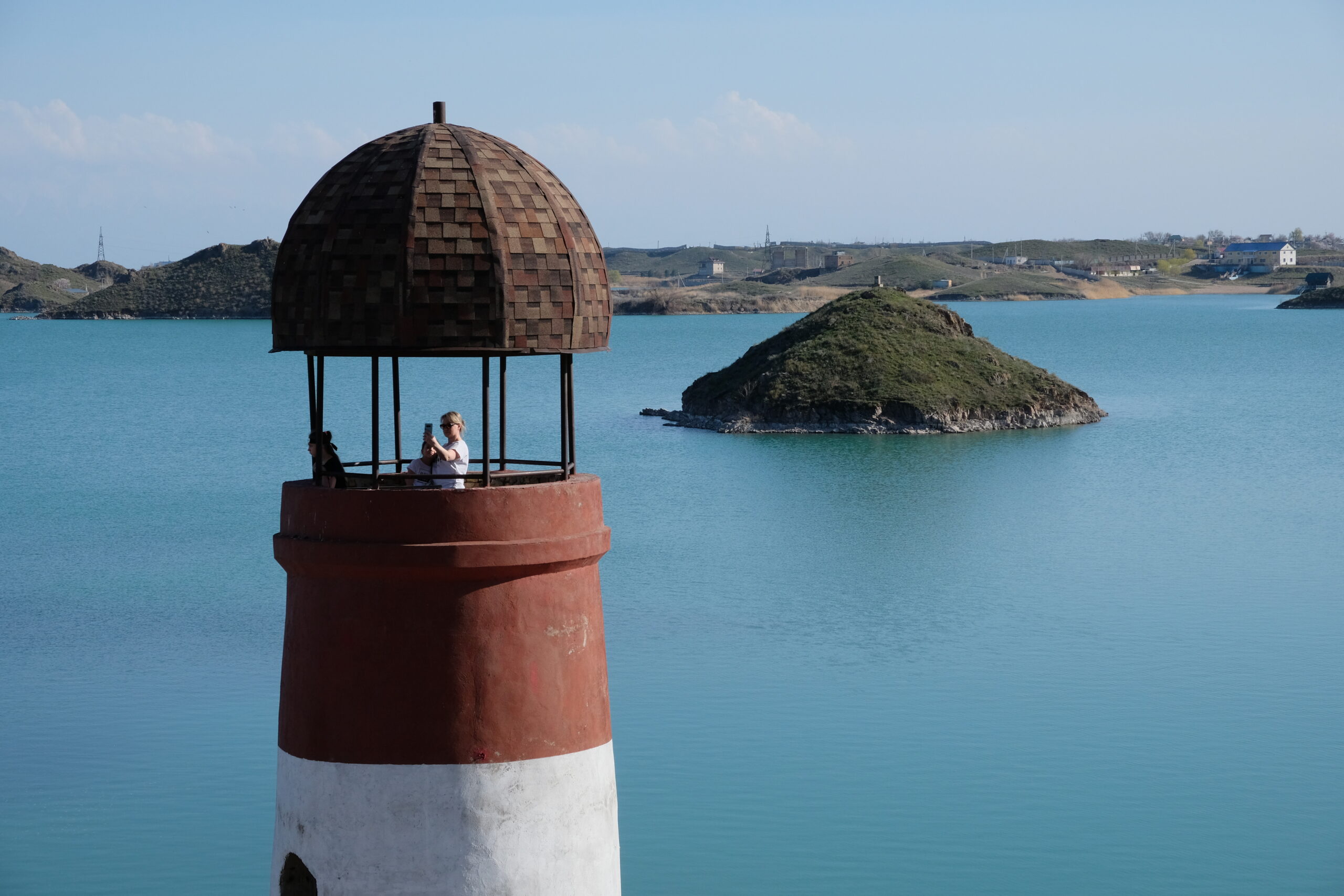Editor’s note: Discover Kazakhstan is a new column dedicated to exploring the rich cultural heritage and natural wonders of the country. Each article explores various aspects of Kazakh life, from traditional cuisine to breathtaking landscapes, offering insights and stories that highlight their unique significance.
Nestled in the scenic mountains near Almaty, Lake Qapshagai (or Kapshagai), also known as the Qapshagai Reservoir, is a blend of natural beauty and essential functionality. Though it may be nearly invisible from ground level, a bird’s-eye view reveals its true splendor. This reservoir is more than a summer retreat for locals; it supports the city throughout the year, providing vital services even in the winter months. Studies suggest Lake Qapshagai also helps reduce the risk of devastating earthquakes in Almaty, highlighting its significance as a steadfast guardian for the city.

Kapshagai from the height of a drone. Photo credit: Shutterstock
A crocodile consumed by a serpent
From a satellite’s perspective, the Qapshagai Reservoir and the Ili River, which flows into and out of it, form a striking visual resembling a crocodile being swallowed by a snake. The reservoir covers an area of 1,847 square kilometers, with a shoreline perimeter of 430 kilometers. The maximum depth reaches 45 meters, with an average depth of 15 meters.

Kapchagay Reservoir. Photo credit: Satellite photography / Alamy
Geographically, the reservoir is bordered to the northeast by the foothills of the Jungar Alatau, and to the south, it merges gradually with the foothills of the Trans-Ili Alatau range. The Ili River, originating in the Central Tian Shan mountains in China, traverses vast landscapes before spreading into the lake. Near Konayev, the river channels narrow due to rocky formations, reflecting the old Kazakh name Qapshağay, meaning ‘narrow gorge’ or ‘dungeon.’ Here, the river is harnessed by the dam, driving the turbines of the hydroelectric power station before flowing through the Zhetisu region to Lake Balkhash.

Kapchagay Ile River Canyon. Photo credit: Shutterstock
During the hot summer months, Qapshagai becomes a popular destination, drawing visitors eager to cool off in its waters or relax on its sandy beaches. The reservoir attracts residents from Almaty, located just 75 kilometers away, offering various recreational spots suitable for different tastes and budgets.
Construction chronicles
The reservoir’s primary purpose goes beyond leisure activities. Its historical and cultural significance adds another layer of intrigue. Constructed in the 1960s as part of a large-scale infrastructure development program in Kazakhstan, the reservoir was designed to ensure a stable water supply during dry periods, regulate the water level of the Ili River, provide drinking water for Almaty’s population, support the operation of the hydroelectric power station, and meet the electricity and water needs of the industrial and agricultural sectors in the Almaty region and beyond.

Decorative lighthouse on Kapshagay ( Qapshagai) reservoir. Photo credit: Adil Abdrakhmanov/Getty Images
The construction began in 1969 with the blocking of the Ili River, and by 1970-1971, the first and last units were commissioned. The hydroelectric power station, completed in 1980, plays a critical role in supplying energy to the Almaty region, including the cities of Almaty, Taldykorgan, and Konayev.
Protection against earthquakes
Interestingly, the reservoir’s presence has been linked to seismic activity. According to Professor Viktor Inyushin, the reservoir’s pressure creates minor, non-destructive earthquakes (technogenic in nature), which can help reduce the likelihood of major, destructive earthquakes. Similar phenomena have been observed around large hydroelectric stations worldwide, suggesting that reservoirs like Qapshagai might serve as protective buffers against severe seismic events.

Kapchagay HEP. Photo credit: Nikolai Bulykin/Wikimedia Commons
Almaty’s primary resort
In winter, the reservoir area can be cold and dry, with temperatures dropping to -12 degrees Celsius, and occasional snowfalls. In contrast, the summer months, from late May to mid-September, are characterized by sunny skies and temperatures ranging from 16-17 degrees Celsius to highs of up to 40 degrees Celsius, especially in July and August. The low humidity makes the heat more bearable, and spring brings a colorful bloom of tulips, poppies, and other plants.

Another attraction of Kapshagai: built for the filming of the movie “City of Nomads”. Photo credit: Shutterstock
The reservoir’s shores are home to the city of Konayev, which offers hotels, beaches, water parks, restaurants, and yachts, making it a major tourist hub. The northern shore features the fishing village, where enthusiasts organize fishing competitions, including national tournaments and local contests.
The northeastern part of the reservoir extends into the Altyn-Emel National Park, home to diverse wildlife and fish species. The park’s ichthyofauna closely resembles that of the reservoir, with twenty-eight fish species inhabiting its waters. Notably, large catfish are a common sight, although myths about these fish swallowing swimmers whole have been debunked by biologists.
Ancient sacred sites of the Saka
The park also features cultural sites sacred to the Kazakh people. Among these are the Bes-Shatyr Saka burial mounds. These mounds hold the remains of Saka nobility dating back to the sixth to fourth centuries BCE. Historians believe they also served as sites for various religious ceremonies and sacrifices. In addition, carvings of mountain goats, boars, wolves, sun symbols, circles, and other signs adorn the stone slabs surrounding individual burials.

Not far from Kapshagai there are petroglyphs of the Tamgaly-Tas tract. Photo credit: Alamy
Archeological excavations in the 1950–60s revealed thirty-one burials, some of which were enormous. For instance, it was estimated that constructing a large burial mound with a diameter of up to 150 meters would take a worker 40,000 days.
So, Qapshagai isn’t just a body of water; it is a treasure trove of history, culture, and natural beauty waiting to be discovered. Next time you find yourself in Almaty, don’t miss the chance to visit the Qapshagai Lake. Whether you’re looking to bask in the sun, take a dip in its refreshing waters, or simply marvel at its engineering prowess, ‘Almaty Sea’ has something for everyone.
Based on an original article by Aeke Qitjanuly, a journalist, historian, and travel guide. The full article can be found on the Qalam project website.


